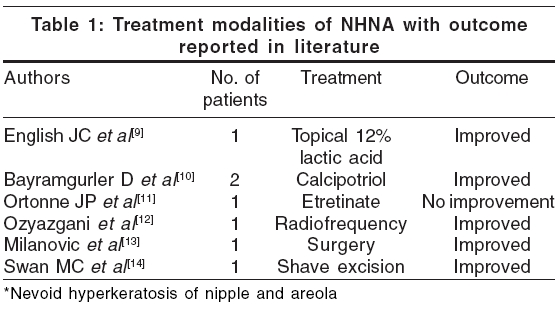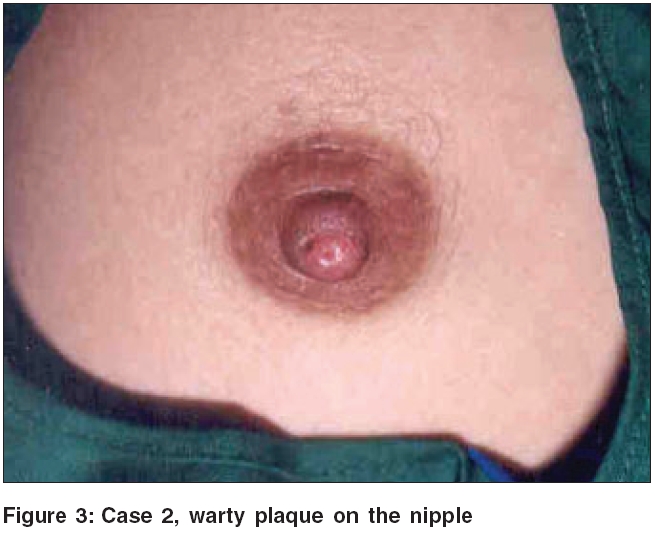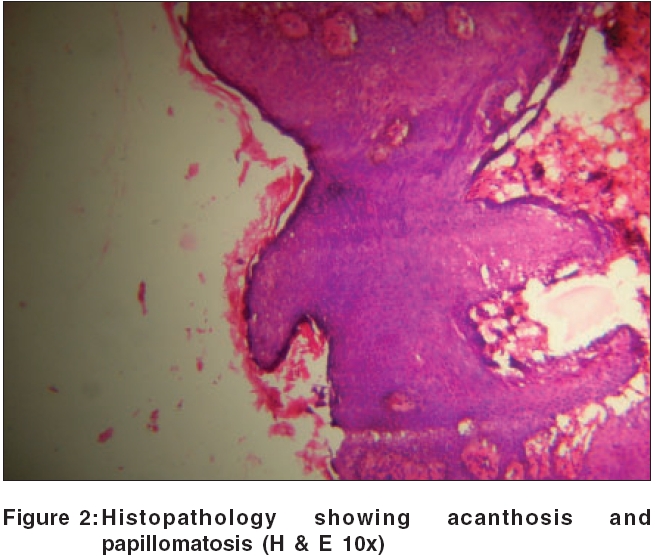Translate this page into:
Unilateral nevoid hyperkeratosis of the nipple: A report of two cases
Correspondence Address:
Veeranna Shastry
Deparment of Skin and STD, J. S. S. Hospital, Mysore, Karnataka
India
| How to cite this article: Shastry V, Betkerur J, Kushalappa P A. Unilateral nevoid hyperkeratosis of the nipple: A report of two cases. Indian J Dermatol Venereol Leprol 2006;72:303-305 |
Abstract
Nevoid hyperkeratosis of the nipple and areola is an unusual condition. Two female patients aged 31 and 18 years presented with chronic unilateral warty lesions of the nipple. One patient had difficulty in breastfeeding from the affected side. A skin biopsy showed acanthosis, hyperkeratosis, papillomatosis, and lymphocytic infiltrate in the dermis. There was no significant improvement with topical tretinoin cream in both the patients.

 |
 |
 |
 |
 |
 |
Introduction
Nevoid hyperkeratosis of nipple and areola (NHNA) is a rare condition, in which the skin of the nipple and/or areola becomes diffusely thickened, hyperpigmented, and covered with filiform or papular warty excrescences.[1] We report two female patients with this rare condition.
Case reports
Case 1 A 31-year-old married woman noted a change in the appearance of the left nipple since 2 years, accompanied initially by mild itching. There was no history of discharge from the nipple. She had delivered a baby boy a year ago. Despite difficulty in breastfeeding from the affected side, she had continued to breast-feed the baby for nine months after the delivery. She was not taking estrogen preparations. She had applied topical steroids and antifungal agents without any improvement.
On examination, the left nipple showed a warty surface and mild scaling [Figure - 1]. There was minimal induration, and no tenderness. There was no discharge or lymphadenopathy. There were no changes in the areola. Breast examination was normal. The right nipple was normal. A skin biopsy taken from the left nipple showed hyperkeratosis, acanthosis, papillomatosis, and keratotic plugging [Figure - 2]. She was treated with topical tretinoin 0.025% cream at night, and an emollient in the morning, without any significant change at the end of one month.
Case 2 An 18-year-old unmarried female presented with a growth on her left nipple, of one year′s duration. There was a history of mild itching initially, but not of pain or discharge. She had received topical antibiotics and steroid creams with no improvement. There was no history of taking estrogen preparation. There was no personal history of atopy.
On examination, there was a brown warty, indurated plaque on the left nipple [Figure - 3]. There was no tenderness, discharge, or lymphadenopathy. Breast examination was normal. The right nipple was normal. A skin biopsy was taken from the left nipple, and showed irregular acanthosis, papillomatosis, hyperkeratosis, and focal hypergranulosis. There was a dense lymphocytic infiltrate in the dermis. The patient was treated with topical 0.05% tretinoin cream, but there was no significant improvement after one month.
Discussion
In 1938, Levy and Frankel described three distinct types of hyperkeratosis of the nipple and areola.[1],[2] Type I was hyperkeratosis as an extension of an epidermal nevus, type II was hyperkeratosis associated with other dermatoses (e.g., acanthosis nigricans, icthyosis, lymphoma, chronic eczema, seborrhoeic keratosis or Darier′s disease), while type III was nevoid hyperkeratosis, not associated with an epidermal nevus or other dermatoses.[2] Perez-Izquierdo suggested an alternative classification of two types: idiopathic or nevoid, and secondary. The latter is due to local factors like acanthosis nigricans, verrucous nevus, seborrheic keratosis; ichthyosis, Darier′s disease, chronic eczema or systemic factors like lymphomas, or drug related e.g., diethylstilbestrol and spironolactone.[1] Mehanna et al . suggested that the term ′nevoid′ should be replaced by ′idiopathic.′[3]
Nevoid hyperkeratosis of the nipple or areola is a rare, idiopathic disorder with approximately 50 reported cases. Although it affects both men and women, approximately 80% of cases occur in women.[4] It presents as hyperkeratotic, hyperpigmented plaques of the nipple and areola. It may also present as a verrucous lesion.[4] There are several reports of unilateral nevoid hyperkeratosis,[5] but the lesions are often bilateral. They may involve the nipple, areola, or both. Of the 45 cases of nevoid hyperkeratosis reviewed by Kubota et al , 17% involved the nipple, 25% the areola, and 58% both the nipple and the areola.[7] The lesions are generally asymptomatic, but occasionally they may be itchy.[5] Difficulty in breast-feeding has been reported.[6]
The etiology of NHNA is not known. A change in estrogen levels has been thought to precipitate this condition.[8] The histopathological changes include orthokeratotic hyperkeratosis, papillomatosis, acanthosis, keratotic plugging, and mild perivascular lymphocytic infiltrate in the dermis.[2] The differential diagnosis of NHNA includes epidermal nevus, acanthosis nigricans, chronic eczema, atopic eczema, seborrheic keratosis, Darrier′s disease, Paget′s disease, basal cell carcinoma, dermatophytosis, and Bowen′s disease.[2] There is no definite treatment for this condition. Various modalities such as topical corticosteroids,[2] tretinoin, keratolytics,[9] calcipotriol,[10] etretinate,[11] radiofrequency,[12] surgery,[13] and shave exicision[14] have been tried [Table - 1].
We made the diagnosis of unilateral nevoid hyperkeratosis of nipple, based on clinical and histopathological features. Though the nipple shows minimal changes, the changes were significant when compared with the normal right nipple. Prolonged friction and rubbing of nipple can induce thickening and hyperkeratosis (jogger′s or cyclist′s nipple).[1] This can mimic NHNA. However, our patients had minimal itching in the initial stage, and there was no history of chronic scratching or rubbing of the nipple. There had been no response to the application of a topical corticosteroid in the past. In both patients, histopathology showed benign epidermal hyperproliferative changes; there was no evidence of pre-malignant or malignant changes. Treatment with topical tretinoin had no effect on the lesion.
We report these two patients of nevoid hyperkeratosis of the nipple and areola for the rarity of this condition. Although there is only one case of NHNA reported from India,[15] the condition may be under-reported because of lack of awareness.
| 1. |
Burns DA. The Breast. In : Tony Burns, Breathnach S, Cox N, Griffith C, editors. Rook's Textbook of Dermatology, 7th ed. New York: Blackwell Science; 2004. p. 67.8-67.9.
[Google Scholar]
|
| 2. |
Krishnan RS, Tiffany, Angel A, Roark TR, Sylvia HS. Nevoid hyperkeratosis of the nipple and/or areola: A report of two cases and a review of the literature. Int J Dermatol 2002;41:775-7.
[Google Scholar]
|
| 3. |
Mehanna A, Malak JA, Kibbi AG. Hyperkeratosis of the nipple and areola. Arch Dermatol 2001;137:1327-8.
[Google Scholar]
|
| 4. |
Revert A, Banuls J, Montesinos E, Jorda E, Ramon D, Torres V. Nevoid hyperkeratosis of areola. Int J Dermatol 1993;32:745-6.
[Google Scholar]
|
| 5. |
Vestey J, Bunney M. Unilateral hyperkeratosis of nipple: The response to cryotherapy. Arch Dermatol 1986;122:1360-1.
[Google Scholar]
|
| 6. |
Perez-Izquierdo J, Vilata J, Sanchez J, Gargallo E, Millan F, Aliaga A. Retinoic treatment of nipple hyperkeratosis. Arch Dermatol 1990;126:687-8.
[Google Scholar]
|
| 7. |
Kubota Y, Koga T, Nakayama J, Kiryu H. Nevoid hyperkeratosis of the nipple and areola in a man. Br J Dermatol 2000;142:370-93.
[Google Scholar]
|
| 8. |
Mold DE, Jegasothy BV. Estrogen induced hyperkeratosis of the nipple. Cutis 1980;26:95-6.
[Google Scholar]
|
| 9. |
English JC, Coots NV. A man with nevoid hyperkeratosis of nipple and areola. Cutis 1996;57:3554-6.
[Google Scholar]
|
| 10. |
Bayramgurler D, Bilen N, Apaydin R, Ercin C. Nevoid hyperkeratosis of nipple and areola: Treatment of two patient with topical calcipotriol. J Am Acad Dermatol 2002;46:131-3.
[Google Scholar]
|
| 11. |
Ortonne JP, el Baze P, Juhlin L. Nevoid hyperkeratosis of nipple and areola: Ineffectiveness of etretinate treatment. Acta Dermatol Venereol 1986;66:175-7.
[Google Scholar]
|
| 12. |
Ozyazgan I, Kontas O, Ferahbast.Treatment of nevoid hyperkeratosis of nipple and areola using radiofrequency surgical unit. Dermatol Surg 2005;31:703-5.
[Google Scholar]
|
| 13. |
Milanovic R, Matric K, Stanec S, Zic R, Vlajeic Z. Surgical treatment of nevoid hyperkeratosis of nipple and areola by removal of the areola and reconstruction with a skin graft. Ann Plast Surg 2005;54:667-9.
[Google Scholar]
|
| 14. |
Swan MC, Gwilym SE, Hollowood K, Venning V, Cassell O. Treatment of nevoid hyperkeratosis of nipple and areola by shave excision. Ann Plast Surg 2004;53:510-2.
[Google Scholar]
|
| 15. |
D'Souza M, Gharami R,Chiganti R, Garg B. Unilateral naevoid hyperkeratosis of the nipple and areola. Int J Dermatol 1996;35:602-3.
[Google Scholar]
|
Fulltext Views
10,061
PDF downloads
1,888





